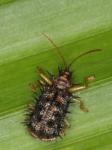Common name
Scientific name
Dicladispa armigera (Olivier)What it does
Rice hispa scrapes the upper surface of leaf blades leaving only the lower epidermis. It also tunnels through the leaf tissues. When damage is severe, plants become less vigorous.
Why and where it occurs
Close spacing causes greater leaf densities that favor the buildup of the rice hispa. The presence of grassy weeds in and near rice fields as alternate hosts harbor and encourage the pest to develop. Heavily fertilized field also encourages the damage.
Heavy rains, especially in premonsoon or earliest monsoon periods, followed by abnormally low precipitation, minimum day-night temperature differential for a number of days, and high RH are favorable for the insect’s abundance.
The rice hispa is common in rainfed and irrigated wetland environments and is more abundant during the rainy season.
How to identify
Check for the following symptoms:
- Scraping of the upper surface of the leaf blade leaving only the lower epidermis as white streaks parallel to the midrib
- Tunneling of larvae through leaf tissue causes irregular translucent white patches that are parallel to the leaf veins
- Damaged leaves wither off
- Damaged leaves turn whitish and membranous
- Rice field appears burnt when severely infested
Hispa feeding damage is similar to feeding marks caused by flea beetles. To confirm cause hispa damage, check for insect presence, and the characteristic feeding marks:
- elongated, clear feeding marks
- white streaks of uneaten lower epidermis between the parallel leaf veins
How to manage
- Avoid over fertilizing the field
- Keep close plant spacing
- Encourage biological control agents: small wasps (attack egg and larvae), reduviid bug (attack adults), three fungal pathogens (attack the adults)
Learn more
View full fact sheet:
Hispa on IRRI Rice Knowledge Bank


